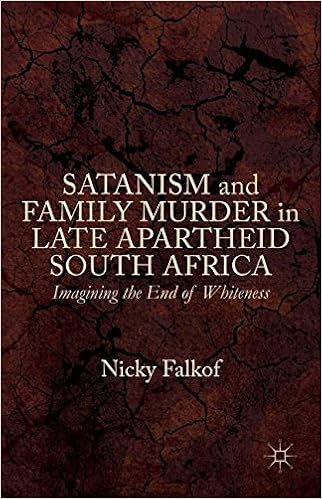
In the last years of apartheid, white South African society found itself in the grip of previously unimaginable social and political change, which sometimes manifested in morbid cultural symptoms. This book considers two of those symptoms, a pair of matched moral panics that appeared in the contemporary media and in popular literature. It argues that excessive reactions to the apparent threat posed by a cult of white Satanists, never proven to exist, and to a so-called epidemic of white family murder reveal important truths about fear, violence and resistance, as well as fragmentations within the poles of white South African identity: nationalism, gender, history, the family, even whiteness itself. Together, the Satanism scare and the family murder ‘epidemic’ draw a compelling picture of the psychic landscape of white culture at the end of apartheid, revealing both pathological responses to social change and the brutalising effects that apartheid had on those who benefited from it most.
 In the last years of apartheid, white South African society found itself in the grip of previously unimaginable social and political change, which sometimes manifested in morbid cultural symptoms. This book considers two of those symptoms, a pair of matched moral panics that appeared in the contemporary media and in popular literature. It argues that excessive reactions to the apparent threat posed by a cult of white Satanists, never proven to exist, and to a so-called epidemic of white family murder reveal important truths about fear, violence and resistance, as well as fragmentations within the poles of white South African identity: nationalism, gender, history, the family, even whiteness itself. Together, the Satanism scare and the family murder ‘epidemic’ draw a compelling picture of the psychic landscape of white culture at the end of apartheid, revealing both pathological responses to social change and the brutalising effects that apartheid had on those who benefited from it most.
In the last years of apartheid, white South African society found itself in the grip of previously unimaginable social and political change, which sometimes manifested in morbid cultural symptoms. This book considers two of those symptoms, a pair of matched moral panics that appeared in the contemporary media and in popular literature. It argues that excessive reactions to the apparent threat posed by a cult of white Satanists, never proven to exist, and to a so-called epidemic of white family murder reveal important truths about fear, violence and resistance, as well as fragmentations within the poles of white South African identity: nationalism, gender, history, the family, even whiteness itself. Together, the Satanism scare and the family murder ‘epidemic’ draw a compelling picture of the psychic landscape of white culture at the end of apartheid, revealing both pathological responses to social change and the brutalising effects that apartheid had on those who benefited from it most.









